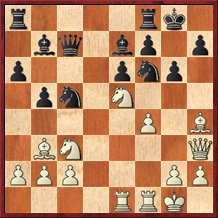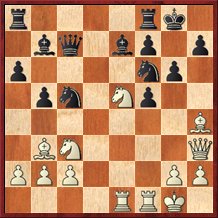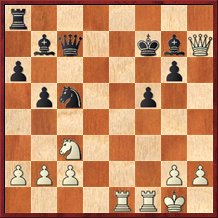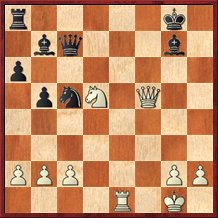My friend Gjon Feinstein, a chess master, is organizing a chess party of sorts this weekend. Everyone is supposed to bring two games: 1) their best-played loss, and 2) a game where they were able to carry out one plan to victory. This was an interesting assignment, and I really look forward to seeing the well-played losses that people will bring.
Just for fun, I did a Google search on the phrase “best-played loss.” Would you believe that these exact words have only appeared on the Internet 8 times (until now)? I was surprised. In four of the eight hits, the phrase appeared in a sentence something like this: “The ugliest win is better than the best-played loss.” Apparently the concept of a moral victory is not a very popular one!
I found a few good losses in my vast collection of defeats over the years, but here is the one that I think I will bring to the party. It’s a game where I did everything right … except win. My opponent (who was rated around 2400) played well, too, except for one inexplicable move.
Dana Mackenzie–Nikolai Andrianov
Western States Open 2003
1. e4 c5 2. f4 d5 3. Nf3?! de 4. Ne5 …
“What is this?” you may be asking. “Why not 4. Ng5, the move you played in your famous queen-sac game against David Pruess?”
The answer is that I had not yet discovered the queen sac variation when this game was played! In many ways, I think that 4. Ne5 is a more natural move, and I may even return to playing it after I get tired of people ducking the queen sac with 4. Ng5 Nf6 5. Bc4 e6.
4. … Nf6 5. Nc3 e6 6. d3! …
Making it a real gambit.
6. … ed 7. Bxd3 Nbd7 8. Qf3 …
Both Fritz and Rybka rate this move about even with 8. Qe2. The latter move controls e5 a little better, but the text move indicates White’s willingness to sac a second pawn for more activity.
8. … a6 9. Be3 Be7 10. O-O …
Perhaps a better option is 10. O-O-O, with the idea of playing for a kingside pawn storm with 11. g4.
10. … O-O 11. Rae1 Qc7 12. Bf2 g6?
This move makes no sense to me, especially coming from a 2400 player. Perhaps he had ideas of trading on e5 and he wanted to stop mate threats on h7 in advance. But the move does not seem forced yet, and it seriously compromises Black’s king position. Rybka shows Black with a slight advantage after the more energetic 12. … b5! White can “win” two rooks for a queen with 13. Qxa8 Bb7 14. Qxf8+, but Black will stand much better because his pieces are more active and the queen and bishop can create very dangerous threats on the long diagonal.
13. Bh4 c4!
A tried-and-true concept: to refute a gambit, accept it and then return it later for a positional advantage.
14. Bxc4 b5 15. Bb3 Bb7 16. Qh3 Nc5?!
The computer says that 16. … Rad8 was better, but the problem with this move is not easy to spot.
How can White exploit the inaccuracy on Black’s last move?
Here are some hints: Look at White’s pressure along the a2-g8 diagonal and the e3 square. Look at the somewhat loose knight on f6, and imagine what would happen if White’s f-pawn were not in the way of the rook. Finally note the undefended position of Black’s queen on c7. Can you find a move for White that takes advantage of all of these themes at once?
The answer is probably obvious by now:
17. f5! …
I always love making a move that my opponent has tried hard to prevent. One point is that 17. … Nxb6 can be met by 18. fg. If 18. … fg then White plays 19. Qxe6+ (the first theme mentioned above) and if 18. … hg then 19. Bxf6 (the second theme above). If instead 17. … gf, then 18. Qg3+ Kh8? (18. … Ng4 is better, but still in White’s favor after 19. Bxe7 and 20. h3) 19. Nxf7+! wins Black’s queen via a discovered attack (the third theme above). Pretty cool! That leaves only one way for Black to play:
17. … ef
And now White faces another challenging decision.
How does White follow up on his pawn sac?
One extremely interesting idea, which turns out to be not quite the best, is the daring rook sacrifice 18. Rxf5!? If Black accepts the rook, then White definitely gets the advantage, thanks again to the third theme: 18. … gf 19. Qg3+ Ng4 20. Bxe7 Qxe7 21. Nxg4 Qxe1 22. Qxe1 fg 23. Qe7! Though material is roughly equal, this is a great position for White’s queen, which is very active, has a crippled pawn on g4 to aim at, and has a nice partner in the knight on c3.
Another move that works out okay for White is 18. … Bc8 (did you see this possibility?) 19. Rxf6!! I really doubt that I would have found this queen sac, but White gets the material back after 19. … Bxh3 20. Nd5! (a monster piece) Bxf6 21. Bxf6 Qb7 22. Ne7+ Qxe7 23. Bxe7 Nxb3 24. Bxf8 Rxf8 25. ab.
The only trouble with 18. Rxf5 is that Black can interpose 18. … Nxb3! and after 19. Bxf6 Nd4! 20. Bxe7 Nxf5 21. Bxf8 Rxf8 Black’s pieces are better placed than White’s. (Analysis by Rybka.)
To be honest, I didn’t see any of this over the board. Ironically, it turns out that I found a better move anyway. Sometimes ignorance is bliss!
18. Bxf7+! Rxf7 19. Nxf7 Kxf7
Beginners sometimes make this trade (giving up two pieces for rook and pawn) thinking that it’s about even. But it’s not! Really you need a rook and two pawns, most of the time, to make full compensation for a bishop and knight. In any normal middlegame position, the two pieces will just eat a rook alive.
But this is not a normal middlegame position! White has some nasty tactics still up his sleeve.
20. Bxf6 Bxf6
Here, believe it or not, Rybka says that Black should play 20. … Kxf6 21. Qh4+ Kf7 22. Qxh7+ Kf6 with a draw by repetition. However, no human would ever play this way.
21. Qxh7+ Bg7
Things still seem to be okay for Black, but now White has a startling combination …
22. Rxf5+? …
Wrong! I have lectured at ChessLecture (in fact, I may have even used this game as an example) about the idea of reversing the move order. White has two key moves, Nd5 and Rxf5+, and it’s important to play them in the right order. I was seduced by the glamor and the glory of the rook sacrifice, but it turns out to have a very subtle flaw. In this case, the knight sacrifice, 22. Nd5!, was actually the correct move order. Then Black is forced to play 22. … Bxd5 23. Rxf5+! gf 24. Qxf5+ Bf6 25. Qxd5+ (the point–this forks Black’s king and rook!) Kg7 26. Qxa8 Bxb2. Now we do have a position where White has rook and two pawns for two pieces. Not only that, the two pawns are connected passed pawns which will be powerful in an endgame, and also Black’s king is very exposed. Finally, queens are still on the board, which is a big difference between this variation and the variation in the game. Black is still alive and kicking and there is no forced win for White, but I would rather be White in this position.
Instead, after 22. Rxf5+ Black played:
22. … gf 23. Qxf5+ Kg8 24. Nd5 …
What is Black’s game-saving (in fact, game-winning) resource?
It looks as if Black is in big trouble, because White threatens 25. Ne7+ with mate to follow. That is, in fact, why I went into this whole line. Of course, 24. … Bxd5? would allow the fork of the king and rook, after which White is a little bit better. But what I missed was that Black has a more effective way of giving back the rook:
24. … Rf8!
The point is that now, in order to win his material back, White is obliged to trade queens. This lands him in a much worse endgame than in the previous variation. Not only are queens off the board (which favors Black because it means his king is in less danger) but also Black has the two bishops, which are more than equal to White’s rook and two pawns.
25. Qxf8+ Kxf8 26. Nxc7 Bxb2 27. Ne6+? …
I was still reeling from the shock of having my attack evaporate and, after all my great play, finding myself in an endgame where I have to fight for a draw. I was also low on time. This move turns out to be a blunder because the knight on c7 was actually helping to control Black’s light-squared bishop. However, I suspect that in the long run this endgame would have been a losing battle. After the text move, White loses rapidly.
27. … Nxe6 28. Rxd6 a5 29. h4 Bd5 30. Ra6 a4 31. g4 Bxa2 32. g5 a3 33. h5 Bd5 0-1
Here I threw in the towel. White has to sac his rook to stop the a-pawn, and Black doesn’t have to sac anything to stop the g- and h-pawns because his bishops are so powerful.
So there’s the best game I ever lost! I played dynamic chess; sacrificed pieces and pawns with gleeful abandon; and had all the right ideas. Unfortunately, I missed just one little move order subtlety and that was the game. Oh, well.
Corrections: I inadvertently neglected Black’s fourth move in the original post and I have now added it. Also, I deleted a reference to 22. Nd5 as being “more prosaic,” because actually there is nothing at all prosaic about a knight sacrifice!







{ 3 comments… read them below or add one }
what’s black’s fourth move? it somehow got lost.
Thanks, Sorcerer88. I fixed it.
Ahh, with Black’s fourth move (which one could have reconstructed but anyways) this is a delightful game, truly worthy of the title ‘best played loss’. should be a fun presentation at the party!
{ 1 trackback }